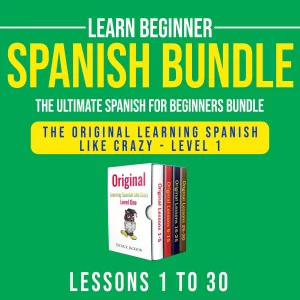
Today I am going to talk about direct speech/quoted speech vs. indirect speech/reported speech in Spanish.
In the Spanish language, this topic of Spanish grammar is called “estilo directo” vs. “estilo indirecto.” In English, direct style vs. indirect style.
In both Spanish and English, we have two different ways to express what someone else says:
1. direct speech/quoted speech (“estilo directo”)
2. indirect speech/reported speech (“estilo indirecto”)
Direct speech is easy to understand. You simply take the exact words of the original speaker and put them in quotes.
Patricio dice, “quiero ir al cine.”
Patrick says, “I want to go the movies.”
Claudia pregunta: “¿Dónde están las medias moradas?”
Claudia asks, “Where are the purple socks?”
In both Spanish and English, indirect speech/reported speech (“estilo indirecto”) is more complicated than direct speech/quoted speech (“estilo directo”).
With indirect speech (“estilo indirecto”), the original speaker’s words are reported without quotes and are usually introduced by the clause “que.”
It may also be necessary to change subject pronouns and possessives when using indirect speech (“estilo indirecto”):
ED: Patricio dice, “(yo) quiero mi cuaderno.”
DS: Patrick says, “I want my notebook.”
EI: Patricio dice que (él) quiere su cuaderno.
IS: Patrick says that he wants his notebook.
In this example, the pronouns changed:
“I” became “he” and “yo” became “él”
The possessives also changed:
“my” became “his” and “mi” became “su”
These aren’t the only changes that may take place when going from “estilo directo” to “estilo indirecto.”
With indirect speech (“estilo indirecto”), you may also need to change Verbs in two different ways: a) You may need to change verbs to agree with the new subject. Let’s look at the above example sentences again:
ED: Patricio dice, “(yo) quiero mi cuaderno.”
DS: Patrick says, “I want my notebook.”
EI: Patricio dice que (él) quiere su cuaderno.
IS: Patrick says that he wants his notebook.
Notice that “quiero” changed to “quiere” when changing from “estilo directo” to “estilo indirecto”?
b) You may also need to change the tense of the verb so that the phrase is logical.
IMPORTANT NOTE: As indicated in the above examples with Patricio wanting his notebook, when the verb in the main clause is in the present tense, there is NO change in tense.
Let’s now look at some examples when the verb in the main clause is NOT in the present tense but is in the past tense:
ED: Patricio dijo, “quiero mi cuaderno.”
DS: Patrick said, “I want my notebook.”
EI: Patricio dijo que quería su cuaderno.
IS: Patrick said he wanted his book.
ED: Claudia preguntó, “¿Dónde están las medias moradas?”
DS: Claudia asked, “Where are the purple socks?”
EI: Claudia preguntó dónde estaban las medias moradas.
IS: Claudia asked where the purple socks were.







Tham gia cộng đồng game thủ tại Go88 để trải nghiệm các trò chơi bài, poker phổ biến nhất hiện nay.
kuwin sở hữu kho game đa dạng từ slot đến trò chơi bài đổi thưởng, mang đến cho bạn những giây phút giải trí tuyệt vời.
Khám phá thế giới giải trí trực tuyến đỉnh cao tại MM88, nơi mang đến những trải nghiệm cá cược thể thao và casino sống động.
iwin – nền tảng game bài đổi thưởng uy tín, nơi bạn có thể thử vận may và tận hưởng nhiều tựa game hấp
采用高效谷歌外推策略,快速提升网站在搜索引擎中的可见性与权重。谷歌外推
kuwin sở hữu kho game đa dạng từ slot đến trò chơi bài đổi thưởng, mang đến cho bạn những giây phút giải trí tuyệt vời.
搭载智能站群程序,自动化搭建与管理,为SEO项目提供核心驱动力。站群程序
Đến với J88, bạn sẽ được trải nghiệm dịch vụ cá cược chuyên nghiệp cùng hàng ngàn sự kiện khuyến mãi độc quyền.
iwin – nền tảng game bài đổi thưởng uy tín, nơi bạn có thể thử vận may và tận hưởng nhiều tựa game hấp
This is my first time pay a quick visit at here and i am really happy to read everthing at one place
Смотреть
um blog realmente muito interessante . É ótimo
quando localizamos material deste nível para
lermos . obrigado pelas dicas . Abraços
Eu gostaria de falar gratidão pelo seu post, tem escrito
em um outro blog de assunto diferente e vou dizer
pra você também. Eu estou para ver outro post de mesmo nível
que este artigo seu. Na verdade, sua criatividade tem me inspirado
muito e eu vou conseguir fazer meu próprio site com esta sua ajuda.
Obrigado!
I wanted to compose you a bit of observation to finally say thank you yet again regarding the nice techniques you have documented at this time. It is quite wonderfully generous of people like you in giving extensively just what a lot of people would’ve offered for sale as an e-book in making some cash on their own, chiefly seeing that you could have done it if you ever decided. These strategies additionally served as the huge way to be sure that someone else have the identical fervor just like my own to discover out good deal more with regards to this problem. I know there are plentiful more agreeable instances ahead for people that take a look at your web site.